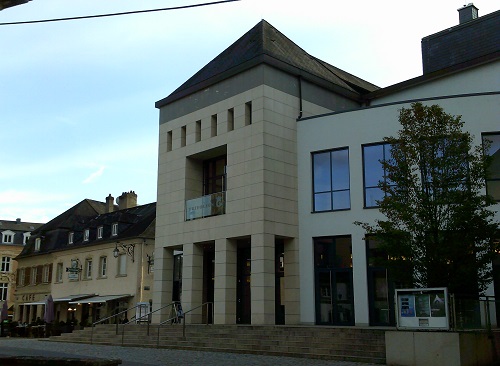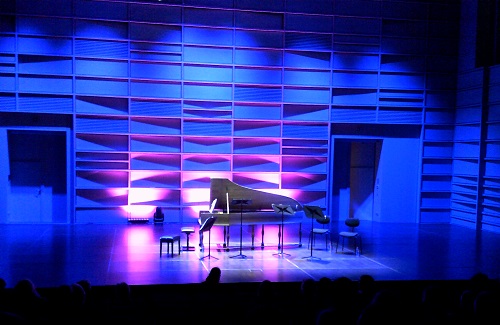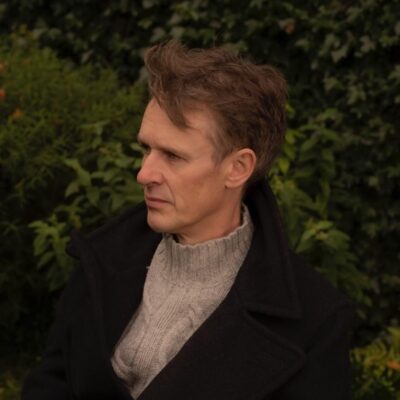The website of the Echternach Tourist Office tells me that this small medieval town (5,600 inhabitants) in the east of Luxembourg, nestled next to the German border, is one of Europe’s earliest centres of culture and Christianisation: ‘Saint Willibrord from Northumberland founded a Benedictine abbey here in 698’ which later ‘became an artistically refined writing school’. Alongside the abbey, the architectural heritage of the town is rich: there’s a Roman villa, a Romanesque basilica, the ancient Church of St Peter and St Paul with its Merovingian, Gothic and Romanesque elements, an Orangerie, a rococo Pavilion, as well as many eighteenth-century patrician houses huddled around the large market square.
In the centre of the town, the five-storey Trifolion, which hosts cultural and social events and conferences, and which opened in 2008 on the site of a former monastery, distinguishes itself from its surroundings. Its gracious atrium and modern concert hall were the venue for this opening concert of the 2023 Echter’Classic festival, which features three days of classical music in various venues in the historic centre of the city, including the Hall of Mirrors of the Lycée Classique d’Echternach and the Basilica of St. Willibrord. Tenor Ian Bostridge and members of Christophe Rousset’s Les Talens Lyriques presented an intimate programme of songs by Michel Lambert and Henry Purcell, interspersed with instrumental music by Corelli and Handel, and concluding with one of Handel’s early secular cantatas of love and longing.
The idiom, manner and intent of the air de cour – the accompanied monodic love song which derived from the French court of the early seventeenth century, and which was as much a social genre as a musical form – are idiosyncratic, shaped as they were by French cultural sensitivities in contradistinction to popular Italian tastes of the time. Elegance, clarity and authenticity were favoured over what was seen as the vulgarity, even violence, of Italian music, and the aim was to provoke powerful emotional responses in the listener.

Bostridge and Les Talens Lyriques began their recital with four airs de cour by Michel Lambert – acknowledged master of the French art song – most of them taken from his final publication of 1689 (when, somewhat ironically, monodic song was beginning to be succeeded in popularity by more complex forms). Bostridge’s light lyrical tenor is the ideal instrument through which to convey the amorous strategies of these Gallic texts and musical mannerisms, and if originally the airs would have been most likely accompanied by lute then here the small instrumental forces – Gilone Gaubert and Marco Kerschbaumer (violins), Emmanuel Jacques (cello) and Christophe Rousset (harpsichord) – balanced perfectly, and with timbral variety, with the melting vocal melodies.
It was a pity that the texts to these airs, and the other vocal items, were not provided, but Bostridge’s sensitivity to the passionate, sometimes wry, lyrics was exquisite. One could not have doubted that, whether the tone was haunting or humorous, romantic or ribald, love was at the core. ‘Ombre de mon amant’ (Shadow of my lover) lies fairly low in the tenor range, and the opening was appropriately dark, but Lambert’s characteristic ornamentations of the vocal line, and upwards-reaching appoggiaturas imbued lightness and lift, and the repeated, tortured cry, “Hélas! que voulez-vous! je meurs”, was vivid in its pained intensity. Voice and bass alone often alternated with the full ensemble, creating forward momentum, though ‘D’un feu secret je me sens consumée’ (I am consumed by a secret fire) ended with startling abruptness.
‘Ma bergère est tendre et fidèle’ (My shepherdess is tender and faithful) was impassioned and highly coloured. The final song, ‘Rochers, vous êtes sourds’ (Rocks, are you deaf?) was an elaborate exhortation, richer and more decorative – dare one say almost Italianate or Monteverdian? – but always delivered with a delicious lightness. These songs are delicate and precious – the palette is pastel not primary – but the moods linger, even as the poet-singers languish, and Bostridge hinted at the emotive exuberance beneath the surface purity. While some listeners may find them monotonous, I find them hypnotic, and could happily while away a whole evening pondering their elegant French sensibility. How sad it seems that Lambert’s name was rather swept aside by the rising tide of French opera, led by his son-in-law Lully (whom he outlived).

What a difference a hundred years, travel across the Channel and a contrasting social, political and cultural milieu make! Five songs by Henry Purcell, drawn from Orpheus Britannicus – the memorial collection of the English composer’s songs which was published by Henry Playford in 1698 and reissued in various forms through most of the next century – created an entirely new musical world. These songs are theatrical, mischievous and often boisterous, part of a dramatic medium which was a complex amalgam of forms. And, frequently, as scholar Curtis Price has observed, they were varied and designed to “satisfy the audience’s voguish whims”. Yet, for all their flamboyance, Purcell’s songs possess their own musical elegance and wit, different but equal to Lambert’s French airs.
‘Celia has a thousand charms’ was first sung in a play titled The Rival Sisters and is a sort of recitative-ballad, beginning in declamatory style and then proceeding in earthy ballad fashion. It was robustly sung here, as was the brisk and breezy ‘From rosy bowers’, which – in D’Urfey’s Don Quixote – is sung by Altisidora, who entertains the company by pretending to be hopelessly in love with Don Quixote, her feigning of ‘madness’ in her doting serving as proof to her audience of her wit. Through the fairly high tessitura and melodic ascents Bostridge conveyed a quasi-hysterical lovesickness, and both the changeable moods – D’Urfey lists the sections of his song: ‘Love, Gaiety, Melancholy, Passion, and Frenzy’ – and fragmentation of the vocal line contributed to the emotional instability of the singer’s sentiments, confirming the striking calculations made by Altisidora to afford every opportunity for vocal display (and dancing prowess – not indulged here!) and accomplishment. Both ‘Sweeter than roses’ and ‘Music for while’ were highly cultivated. In the former, Bostridge wrang every ounce from the textual repetitions; the tempo of the latter was pleasingly flowing. ‘The bashful Thames’ communicated all of Purcell’s daring harmonic freedoms and inspired theatricality.
Musical palettes were cleansed by Corelli: in between the French and English sojourns, we heard the Italian composer’s Trio Sonata in G minor Op.3 No. 11 and the ‘Ciaconna’, Trio Sonata in G major Op.2 No.12 – the first a sonata da chiesa (suitable for use in church), the second a sonata da camera (for use at court). These were alert and incisive performances, seemingly nonchalant in their grace and fleetness, but detailed of colour and texture. The ‘Ciaconna’, in particular, was a feast of rich thirds and sixths in the duetting violins, articulated with bowing by turns silkily smooth and brightly vigorous, which built into a fountain of energy and esprit.
The second half of the concert focused on Handel in his Italianate mode, the second of the Op.2 Trio Sonatas forming a somewhat serious prelude to the secular cantata Clori, mia bella Clori. Despite their 1733 publication date, the Op.2 sonatas are believed to have been composed by the early 1720s and reveal the young Handel showing his prowess in the Corellian sonata da chiesa genre, with its slow-fast-slow-fast format. The second of the set of six, in G minor, was played with refinement by Les Talens Lyriques, tempi judiciously chosen to allow the music to breathe, and ornamentation only rarely applied, in keeping with the rather grave tone of the sonata. There was no lack of variety though, delicacy and vigour being nicely juxtaposed, and rhythms flexible. I particularly liked the way the vibrato that warmed the cello line at the end of the Largo both deepened that movement’s sentiments and anticipated the vividness of the final Allegro. The performance convinced that these sonatas were not just for playing but for listening too.

Clori, mia bella Clori is one of the more than one hundred secular cantatas of love and longing which Handel composed during his prodigious Italian sojourn of 1707-10. During this time his Roman patrons included the Cardinals Pamphili, Ottoboni and Colonna, but this cantata is assumed to be that which is referred to, on 28th August 1708, in the account books of Marquis Francesco Maria Ruspoli: ‘Cantata à voce sola con VV’. In four recitative-arias a forlorn shepherd bemoans his separation from his beloved Clori, rejoices that her spirit is reflected in the pastoral landscape, is overcome by tears and finally succumbs to an outburst of jealousy.
The changing emotions are reflected by the instrumental variety that Handel garners from his two violins, bass and continuo, and in the restrained opening aria, ‘Chiari lumi’, the directness of the vocal expression of despair was enhanced by the simplicity of the violins’ unisons and their telling silences. The solace of pastoral delights, in which roses and lilies are playfully personified as Love, was conveyed in ‘Ne’ gigli e nelle rose’ by the lightly tripping triple-metre, voice and bass conversing excitedly, and the vocal line unfolding in extended, asymmetrical phrases, with the violins intensifying the closing ritornello. Bostridge, characteristically, made much of the melismatic weeping in ‘Mie pupille’, his light tenor just right for the languid despondency of “lacrimar”, and paradoxically both deepened and sweetened by the violins’ softening thirds. ‘Di gelosia il timore’ was fast and furious, with full but springy instrumental textures and incisive motifs and accents. Bostridge again made much of the text, sometimes seeming to spit out the shepherd’s riling resentment. The stylistic sensitivity that had characterised the whole concert was much in evidence here. One wonders, though, if in that Roman palace, just over three hundred years ago, the lovelorn lad’s lamenting might not have been a little more tongue-in-cheek?
‘Where’er you walk’ from Handel’s Semele was the evening’s encore, the subtle sophistication of the musical and verbal nuance intensely expressive and satisfying.
Claire Seymour
Ian Bostridge (tenor), Les Talens Lyriques: Gilone Gaubert (violin), Marco Kerschbaumer (violin), Emmanuel Jacques (cello), Christophe Rousset (harpsichord / conductor)
Michel Lambert (c. 1610-1696) – Airs de cour: ‘Ombre de mon amant’ (1689), ‘D’un feu secret je me sens consumer’ (1660), ‘Ma bergère est tendre et fidèle’ (1689), ‘Rochers vous êtes sourds’ (c. 1692); Arcangelo Corelli(1653-1713) – Trio Sonata Op.3 No.11 in G minor (1689), Ciacona from Trio Sonata Op.2 No.12 in G major (1685); Henry Purcell (1659-1695), from Orpheus Britannicus (ed.1698 and 1702) – ‘Celia has a thousand charms’ Z609, ‘From Rosie Bowr’s’ (from Don Quixote Z578), ‘Sweeter than roses’ (from Pausanius, the Betrayer of his country Z585), ‘Music for a while’ (from d’Œdipus Z583), ‘The bashful Thames’ (from Yorkshire Feast Song Z333); George Frideric Handel (c. 1685-1759) – Trio Sonata Op.2 No.2 in G minor HWV 386b (1733), Clori, mia bella Clori HWV 92 (c.1707-08).
Trifolion, Echternach, Luxembourg; Thursday 5th October 2023.